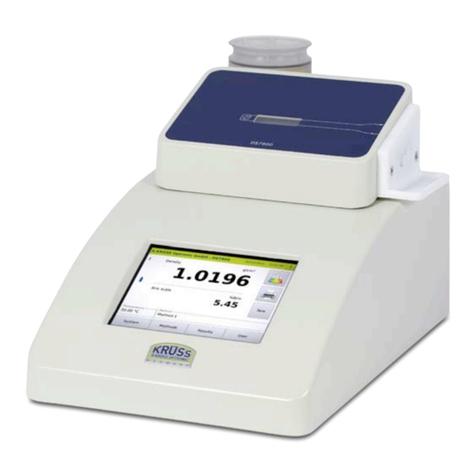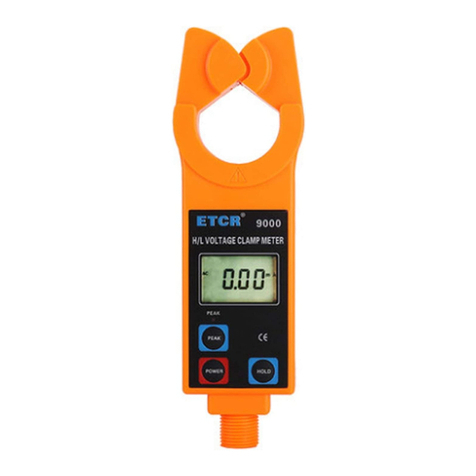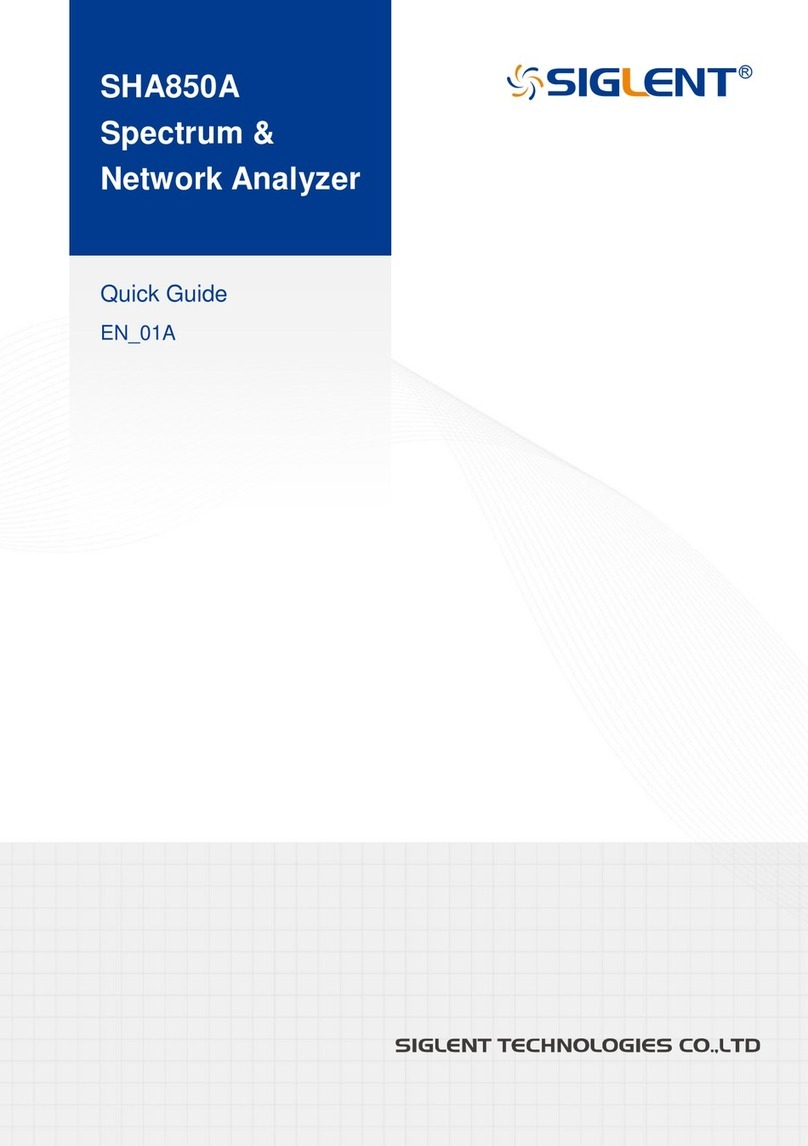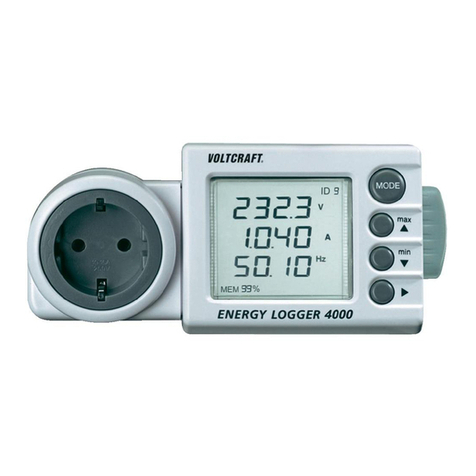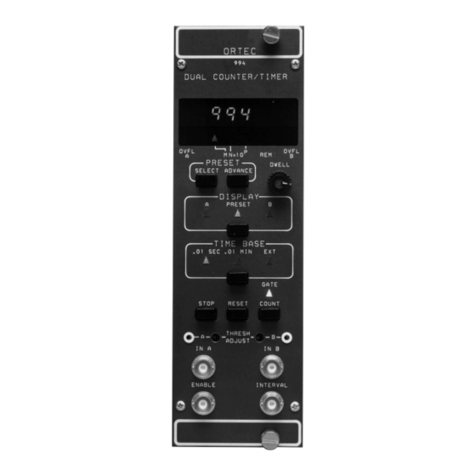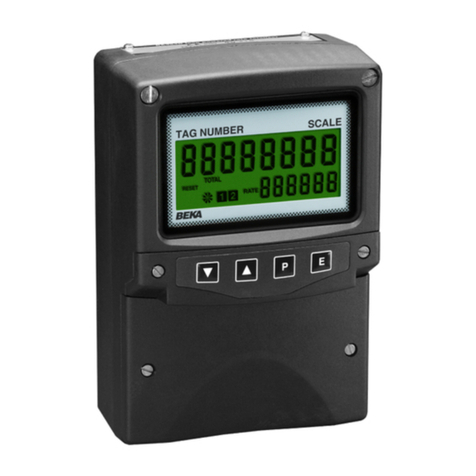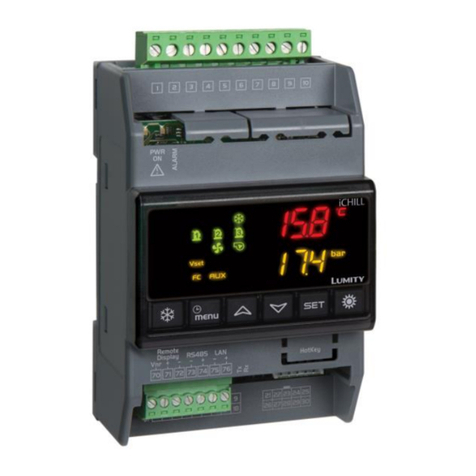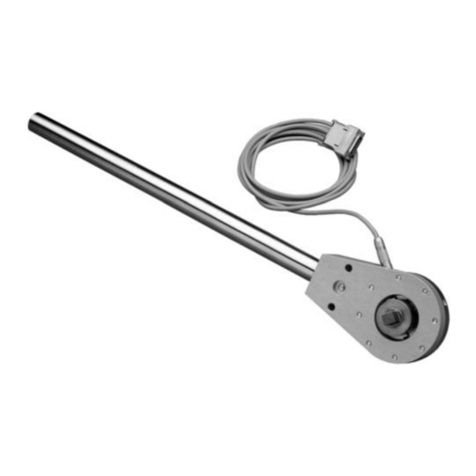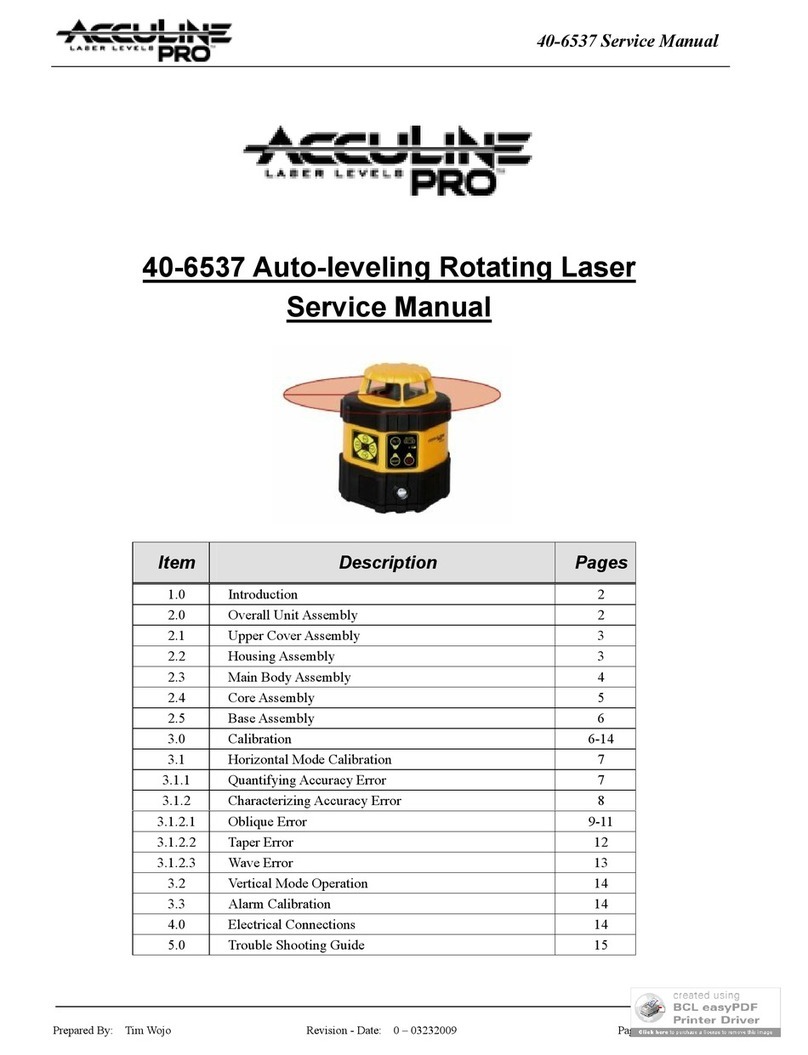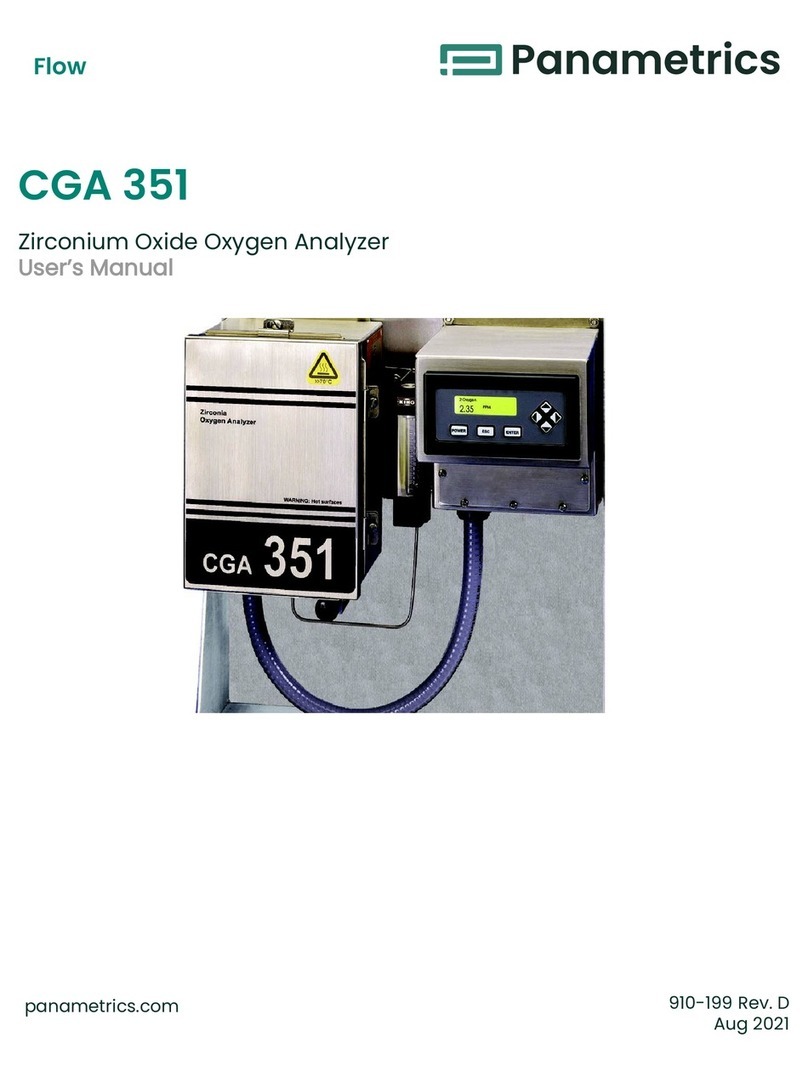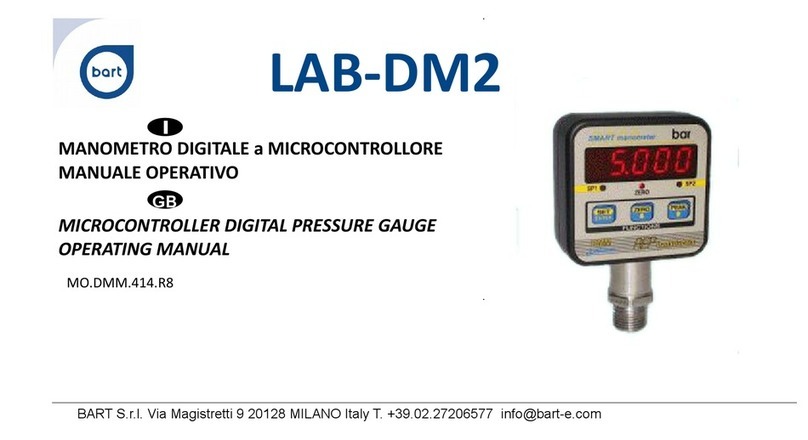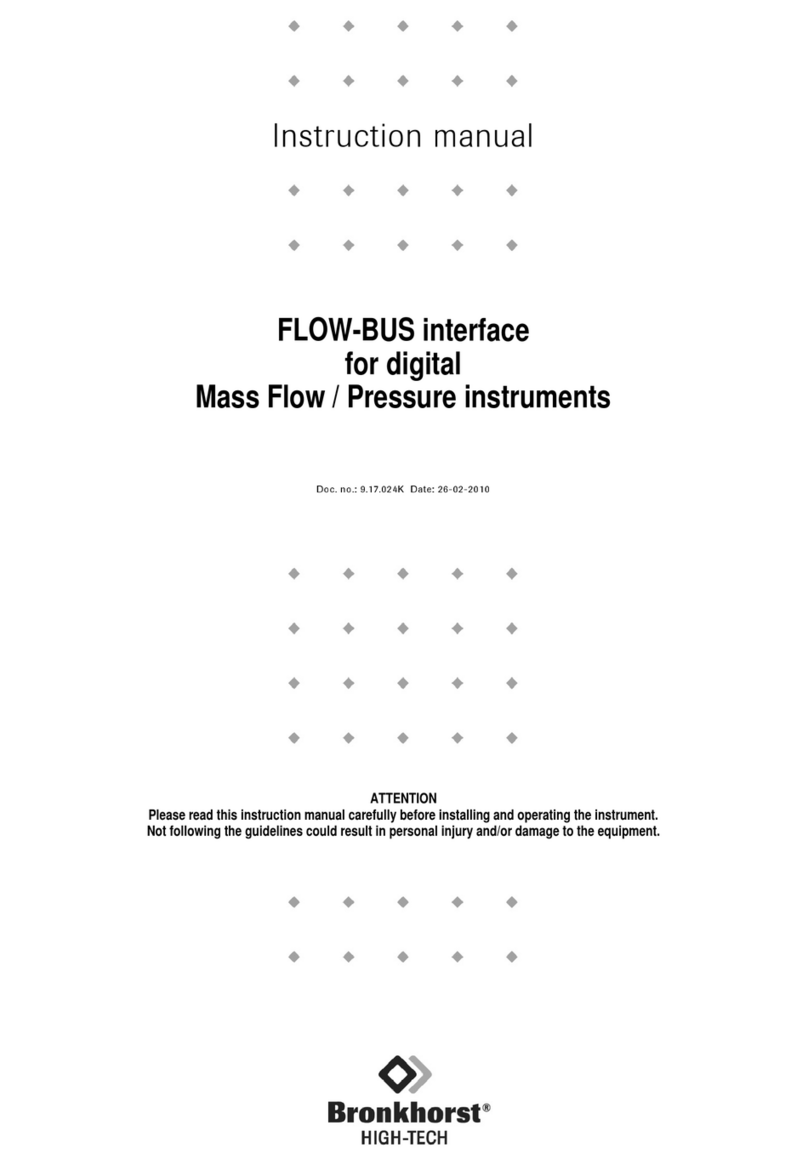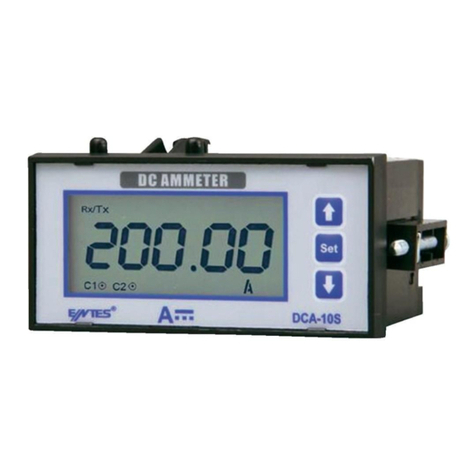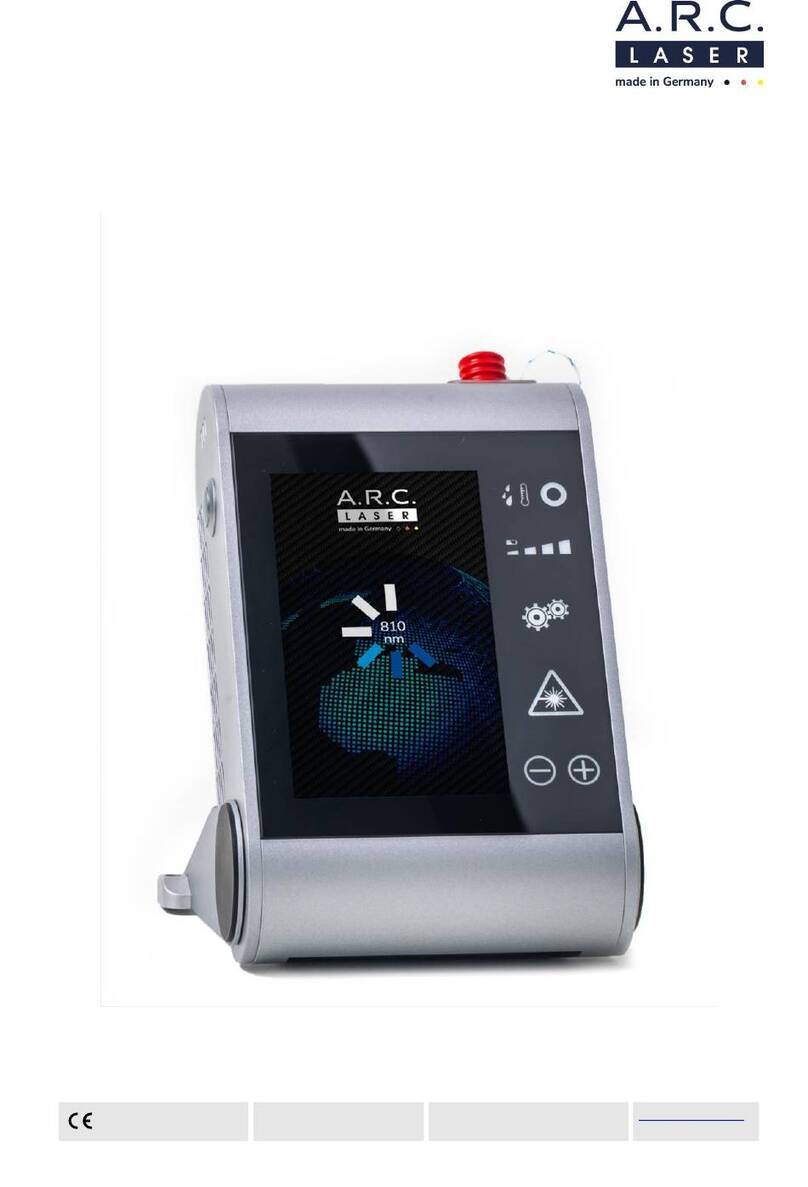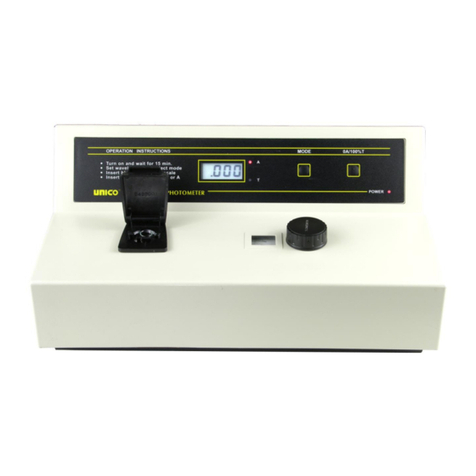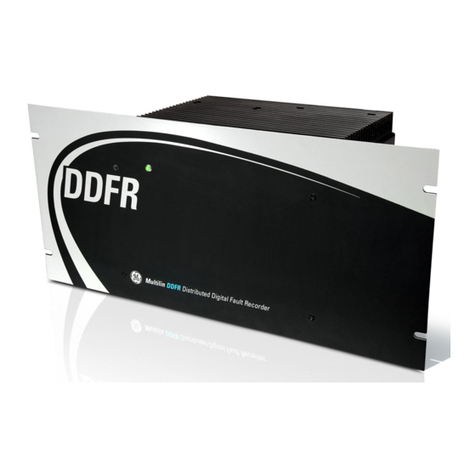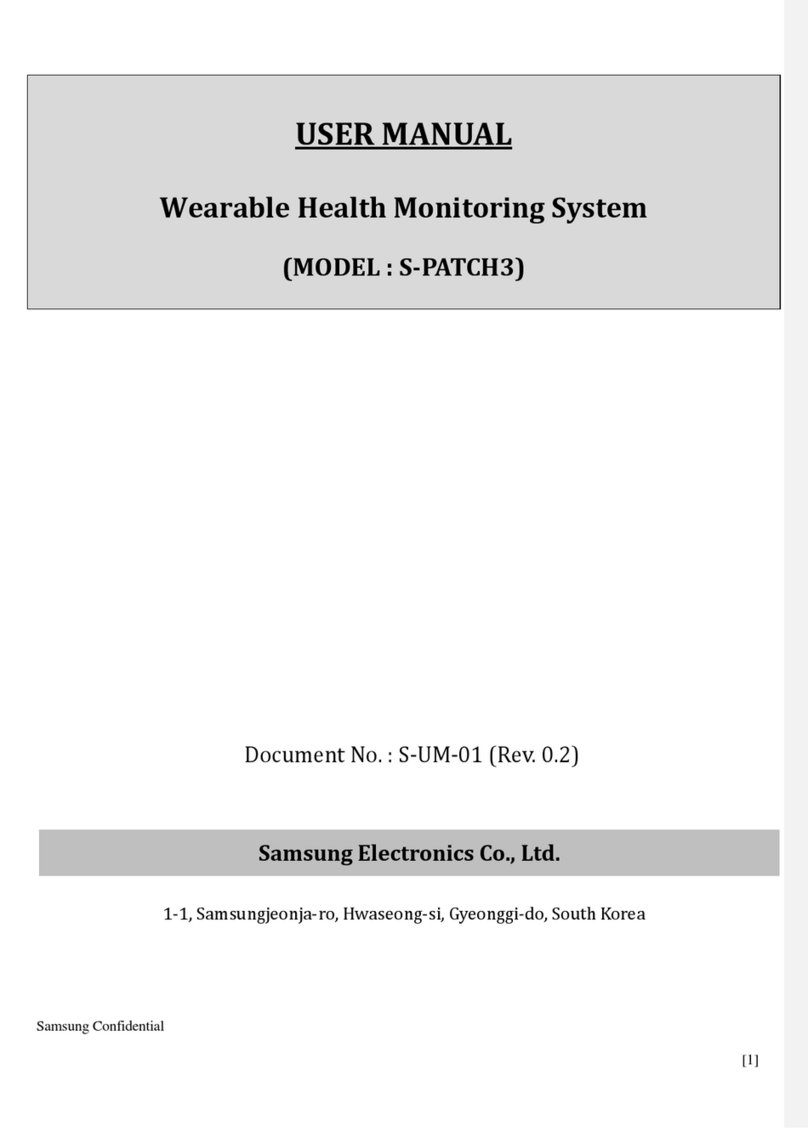kruss DR201-95 User manual

Instruction Manual DR201-95 | Version 3.1 © A.KRÜSS Optronic 2022 |Page 2of 30
en
Preface
▪The information provided in this INSTRUCTION MANUAL is essential for the
assembly and safe operation of A.KRÜSS devices.
▪The information is presented in a brief, clearly arranged format. The chapters are
numbered throughout.
▪Please note that we reserve the right to make changes to design, equipment, and
technology. For this reason, no claims concerning specific features of the device
can be derived from the content of this instruction manual.
Representational conventions
CHARACTER
DESCRIPTION
Additional information, explanations, and references outside
the current action step
1)
Legend reference
At the beginning and end of the sections covering action
guidelines. For: REQUIREMENT, procedure, and result
1.
Indicates the sequence of action steps
Background information on the relevant action step
✓
Indicates partial results or interaction results in action
guidelines
At the beginning of corrective measures listed in the chapter
Troubleshooting
If you have the instruction manual in digital form, the links are interactive.
The keyboard combination ALT and ←returns you to the starting point.
The table of contens is also interactive.

Instruction Manual DR201-95 | Version 3.1 © A.KRÜSS Optronic 2022 |Page 3of 30
en
Table of contents
1INTENDED USE .......................................................................... 5
1.1 Perfomance description......................................................................... 5
1.2 Permissible usage conditions.................................................................. 5
1.3 Application areas ................................................................................. 6
1.4 Obligations of the operator ................................................................... 6
1.5 General safety recommendations............................................................ 6
2DEVICE DESCRIPTION ................................................................ 7
2.1 Device overview................................................................................... 7
2.2 Measurement scales ............................................................................. 8
2.3 Type plate........................................................................................... 8
2.4 Scope of delivery.................................................................................. 9
2.5 Technical data..................................................................................... 9
2.5.1 Basic device data ..........................................................................................9
2.5.2 Temperature data ...................................................................................... 10
2.5.3 Electrical data............................................................................................ 10
2.6 Measurement principle........................................................................ 10
2.7 Automatic temperature compensation.................................................... 11
3UNPACKING AND COMMISSIONING ....................................... 11
3.1 Unpacking ........................................................................................ 11
3.2 Commissioning.................................................................................. 12
3.2.1 General requirements for operation............................................................. 12
3.2.2 Positioning................................................................................................. 12
3.2.3 Inserting the battery .................................................................................... 13
3.2.4 Switching on the device............................................................................... 13
3.2.5 Test measurement...................................................................................... 13

Instruction Manual DR201-95 | Version 3.1 © A.KRÜSS Optronic 2022 |Page 4of 30
en
4OPERATION ............................................................................ 14
4.1 Adjusting .......................................................................................... 14
4.2 Calibrating........................................................................................ 15
4.3 Measuring ........................................................................................ 16
4.4 Tables.............................................................................................. 17
4.4.1 Table: Dependence of refractive index of distilled water vs. temperature .... 17
4.4.2 Conversion table 1: %Brix and refractive index.............................................. 18
4.4.3 Conversion table 2: %Brix and urea concentration ........................................ 19
4.4.4 Conversion table 3: Refractive index und ethylene glycol................................ 20
4.4.5 Conversion table 4: Refractive index and propylene glycol ............................. 20
5CLEANING AND MAINTENANCE............................................... 21
5.1 Maintenance ..................................................................................... 21
5.2 Cleaning .......................................................................................... 21
5.3 Recommanded sample-specific cleaning agents ...................................... 22
5.4 Exchanging the battery ........................................................................ 23
6TROUBLESHOOTING ............................................................... 24
7DECOMMISSIONING............................................................... 26
8TERMS OF WARRANTY.............................................................. 27
9EC DECLARATION OF CONFORMITY........................................ 28

Instruction Manual DR201-95 | Version 3.1 © A.KRÜSS Optronic 2022 |Page 5of 30
en
1Intended use
1.1 Performance description
The DR201-95 is a compact, mobile, and splash-water proof digital handheld
refractometer. It is used for the measurement of the refractive index (nD) and the
sugar content in % (%Brix) of liquid and viscous samples. The device determines
the refractive index between nD 1.3330–1.5318 and the sugar content in the
range of 0–95 %Brix. The integrated temperature sensor determines the temperature,
which is displayed on the LCD. The digital refractometer offers an automatic
temperature compensation for the whole Brix scale in the range of 10–40 °C. Details
on samples and measurements can be found in the A.KRÜSS Campus.
DEVICE TYPE
DEVICE SPECIFICATION
DR201-95
▪Measurement range from nD 1.3330–1.5318
and 0–95 %Brix
▪Integrated thermometer
1.2 Permissible usage conditions
WA R N ING
Danger arising from impermissible use of devices
➢Only use the device in the prescribed area of application.
➢Do not use the device in hazardous areas.
The device is not designed for use in potentially explosive environments or as a
medical electrical device according to DIN EN 60601-1 or IEC 60601-1.
The device must not be modified in any way whatsoever.

Instruction Manual DR201-95 | Version 3.1 © A.KRÜSS Optronic 2022 |Page 6of 30
en
1.3 Application areas
The DR201-95 is used in the food industry, pharmacies, and investigations offices, as
well as in research and teaching.
The device is suitable for the following investigations and areas of application:
▪Identity tests, purity control and concentration determination of raw materials,
semi-finished products, and end products
▪Determination of sugar concentration
▪Incoming and outgoing goods inspections
▪Controlling foodstuffs and pharmaceuticals
1.4 Obligations of the operator
The operator must ensure that the devices are used exclusively as intended and that
any danger whatsoever to the life, limb, or health of users or third parties are avoided.
In addition, accident prevention regulations and recognised safety rules are to be
observed.
The operator must ensure that all users have read and understood this instruction
manual.
Non-observance of this instruction manual will void the warranty. The same applies if
improper work has been carried out on the device by the customer and/or third
parties without the approval of the manufacturer. Servicing work may only be carried
out by expert A.KRÜSS employees.
1.5 General safety recommendations
▪The device must not be opened since this could affect its functions and safety.
Modifications to device components, e.g. the measurement prism, could lead to
faulty measurement values.
▪Only use fully functional batteries. Batteries which are exposed to mechanical
stress or extreme environmental influences can impair the device function or
safety.
Influences include heat, cold, humidity, corrosion, or vibration.
▪Remove the battery when the device is not in use for an extended period of time;
battery leakage can destroy the device.
▪Do not drop the device as it may thus be damaged.

Instruction Manual DR201-95 | Version 3.1 © A.KRÜSS Optronic 2022 |Page 7of 30
en
2Device description
2.1 Device overview
ITEM
DESIGNATION
1
Measurement prism (Flint glass SF4)
2
Measurement chamber for sample intake (fully chromed)
3
Lid
4
Display (LCD) showing the measured value or the temperature
5
Arrow pictogram showing of the selected measurement scale
6
READ button for switching on the device and starting the
measurement
7
ZERO button
Press once to calibrate
Press and hold to adjust
8
SCALE button for selection of the measurement scale
Figure 1 –DR201-95 (Front view)
1
2
4
5
3
6
7
8

Instruction Manual DR201-95 | Version 3.1 © A.KRÜSS Optronic 2022 |Page 8of 30
en
2.2 Measurement scales
The device contains two
measurement scales: refractive index
(nD) and concentration of sucrose
[%Brix].
The designation BRIX (1) indicate
the measurement scale of the
concentration of sucrose and RI (2)
indicate the refractive index.
▪By pressing the SCALE button (3) you can switch between both measurement
scales. The arrow in the display indicates which measurement scale is activated.
Various conversion tables are included for information, see chapter 4.4 Tables.
2.3 Type plate
POS
Designation
1
Manufacturer’s address
2
WEEE-registration number (according to directive 2012/19/EU)
3
Device type
4
Serial number
5
Electrical data
6
CE-mark
The type plate is located on the bottom of the device.
Figure 2 –Measurement scales
1
2
3
Figure 3 –Type plate
1
2
3
4
5
6

Instruction Manual DR201-95 | Version 3.1 © A.KRÜSS Optronic 2022 |Page 9of 30
en
2.4 Scope of delivery
DEVICE
SCOPE OF DELIVERY
DR201-95
▪Refractometer DR201-95
▪Battery 1.5 Volt AAA
▪Pipette
▪Bottle with distilled water
2.5 Technical data
2.5.1 Basic device data
DESIGNATION
KEY DATA
SCALES
Refractive index (nD)
Concentration of sucrose [%Brix]
MEASUREMENT RANGE
nD 1.3330–1.5318
0–95 %Brix
MEASUREMENT ACCURACY
nD ±0,0003
±0.2 %Brix
RESOLUTION
nD 0,0001
0.1 %Brix
MEASUREMENT PRISM
Optical glass (Flint glass SF4)
MEASUREMENT TIME
approx. 1 second
LIGHT SOURCE
LED
OPERATION
Buttons on membrane keypad
AMBIENT TEMPERATURE
10–35 °C
AMBIENT AIR MOISTURE
10–90 %, non-condensing
IP CODE
IP64, splash-water proof
SAMPLE CONTAINING COMPONENTS
Flint glass SF4, fully chromed sample
intake
HOUSING
Synthetic material (ABS), coated
DIMENSIONS (H x W x D)
130 mm x 80 mm x 40 mm
DEVICE WEIGHT
180 g

Instruction Manual DR201-95 | Version 3.1 © A.KRÜSS Optronic 2022 |Page 10 of 30
en
2.5.2 Temperature data
DESIGNATION
KEY DATA
TEMPERATURE MEASUREMENT
Integrated temperature sensor
TEMPERATURE MEASUREMENT RANGE
10–40 °C
TEMPERATURE MEASUREMENT
ACCURACY
±0.5 °C
TEMPERATURE COMPENSATION
10–40 °C
TEMPERATURE MEASUREMENT
RESOLUTION
0.1 °C
2.5.3 Electrical data
DESIGNATION
KEY DATA
OPERATING VOLTAGE
1.5 V
2.6 Measurement principle
The refractometer measures the refractive index nD of the sample. The refractive index
changes according to the concentration or type of sample.
The sample is placed on the prism
using a pipette. The beam of light
of an LED shines through the
prism onto the sample. Depending
on the limiting angle of total
reflection, which varies
depending on the sample, an
illuminated and an unilluminated
area are created on a
photodetector.
The refractive index is determined from the position of these areas. In addition to the
refractive index, the temperature at the prism is also determined and used for the
automatic temperature compensation.
For more information see Campus Refraktometrie
Figure 4 –Schematic depiction

Instruction Manual DR201-95 | Version 3.1 © A.KRÜSS Optronic 2022 |Page 11 of 30
en
2.7 Automatic temperature compensation
The refractometer provides an automatic temperature compensation for the whole Brix
scale in the temperature range of 10–40 °C. This is permanently active. The
automatic temperature compensation corrects the measurement value in line with the
reference temperature of 20 °C.
This means that regardless of the temperature at which a sample is measured
between 10–40 °C, the device displays the Brix value of the measured sample
for 20 °C.
The following sample illustrates this:
A sucrose solution with a value of 40 %Brix at 20 °C would have a value of
39,2 %Brix at 30 °C. If the sample is measured at 30 °C, the automatic temperature
compensation corrects the measured value and the refractometer displays 40 %Brix.
The automatic temperature compensation is not used for the refractive index scale.
3Unpacking and commissioning
3.1 Unpacking
NOTE
Risk of material damage during transport of the device
➢Check device for transport damage after unpacking.
➢Do not operate damaged devices.
▪When unpacking the device, check if any transport damage has occurred. Take
note of any loose parts, dents, scratches visible damage, etc.
▪Before disposal, inspect the packaging material for any loose functional parts and
safe if necessary.
▪Return the device in the original packaging with the completed return form; see
return form (A.KRÜSS website).

Instruction Manual DR201-95 | Version 3.1 © A.KRÜSS Optronic 2022 |Page 12 of 30
en
3.2 Commissioning
3.2.1 General requirements for operation
WARNI NG
Danger due to unauthorised use of the device
Improper use of device can cause serious accidents.
➢Only use the device in the prescribed area of application.
➢Never use the refractometer in a potentially explosive environment.
3.2.2 Positioning
Securely position the device and observe the following conditions:
▪Choose a plane and non-slip surface.
▪Secure the device against falling down.
▪Do not place the device near table edges.

Instruction Manual DR201-95 | Version 3.1 © A.KRÜSS Optronic 2022 |Page 13 of 30
en
3.2.3 Inserting the battery
To insert the battery
1. Open the flap (1) on the bottom of the device.
2. Insert the battery into the battery housing (2), observing the indicated polarity,
and close the cover.
3. Finally close the flap.
3.2.4 Switching on the device
1. Switch on the device by pressing the READ button (3).
✓The current prism temperature is displayed.
If not in use, the device switches off automatically after 3 minutes.
3.2.5 Test measurement
▪For commissioning and daily use, we recommend that an adjustment be carried
out with distilled water.
Figure 5 –DR201-95 insert the battery
1
2
3

Instruction Manual DR201-95 | Version 3.1 © A.KRÜSS Optronic 2022 |Page 14 of 30
en
4Operation
4.1 Adjusting
▪In daily use, we recommend that the device be calibrated with distilled water and
adjusted if necessary.
▪In an adjustment, a sample, usually a calibration standard, is measured with a
known setpoint. The device is adjusted on the basis of the comparison between
the measuring result of the device and the setpoint. The adjustment permanently
changes the device and minimises the deviation between the measurement result
and the setpoint.
▪For adjustment of the refractometer a temperature compensation for distilled water
is used. Therefore only distilled water is to be used.
▪Before the adjustment begins, we recommend that the refractometer, the water for
adjusting and the environment have the same temperature.
Adjusting
REQUIREMENT
▪Switch on the device.
PROCEDURE
1. Pour about 0.4 ml of distilled water onto the measuring prism.
The prism must be completely covered.
Ensure that there are no bubbles in the sample.
2. Close the lid of the device.
3. Wait for 5 seconds after pouring the water onto the prism.
4. Press the ZERO button and keep it pressed until "CAL" and "END" are displayed in
succession.
5. Carefully clean the measuring prism with a soft, dry cloth.
RESULT
The adjustment of the device with distilled water has been carried out.
To check whether the adjustment has been carried out correctly, the refractometer
can be calibrated with distilled water.

Instruction Manual DR201-95 | Version 3.1 © A.KRÜSS Optronic 2022 |Page 15 of 30
en
4.2 Calibrating
▪To check whether an adjustment has been carried out correctly or to determine the
deviations between measured values and expected values, the device can be
calibrated.
▪For calibration, a sample usually a calibration standard is measured with a known
setpoint. Comparing the measurement result of the device with the setpoint will
reveal deviation of the device.
Calibrating
REQUIREMENT
▪Switch on the device.
PROCEDURE
1. Pour about 0.4 ml distilled water onto the measuring prism.
The prism must be completely covered.
Ensure that there are no bubbles in the sample.
2. Close the lid of the device.
3. Wait for 5 seconds after pouring the water onto the prism.
4. Briefly press the ZERO button once.
5. Check that the displayed reading is between nD 1.3327 and 1.3333.
The device displays the refractive index of distilled water for 20 °C.
Due to the tolerances of the refractometer, the range of the expected
measured value is given.
6. Carefully clean the measuring prism with a soft, dry cloth.
RESULT
Calibration of the device with distilled water has been carried out.
If the measured value at the measuring temperature lies beyond the tolerances,
repetition of the measurement is recommended after thorough and residue-free
cleaning of the prism.
If the deviation remains unchanged, an adjustment should be carried out.
If the refractometer is to be calibrated with (certified) calibration standards, this
can be done with measurements obtained via the READ button.

Instruction Manual DR201-95 | Version 3.1 © A.KRÜSS Optronic 2022 |Page 16 of 30
en
4.3 Measuring
▪In order to avoid contamination and damage of the prism as well as sample carry-
over, clean the prism immediately after the measurement.
Make sure that the sample does not come in contact with the housing of the
refractometer. Any sample material on the housing should be removed
immediately.
Measuring samples
REQUIREMENT
▪Switch on the device.
PROCEDURE
1. Pour about 0.4 ml distilled water onto the measuring prism.
The prism must be completely covered.
The sample must not contain any bubbles.
2. Close the lid of the device.
3. Wait for 5 seconds after pouring the water onto the prism.
4. Press the READ button once.
✓After 1 second, the measured value is displayed in the currently selected
measurement scale.
To obtain the measured value of the same sample in the second measurement
scale change the scale. Afterwards measure the sample once more.
5. Carefully clean the measuring prism with a soft, dry cloth.
When cleaning, use a solvent suitable for the sample material for cleaning. For
details see chapter 5.3 Recommended sample-specific agents.
RESULT
The measurement has been carried out.

Instruction Manual DR201-95 | Version 3.1 © A.KRÜSS Optronic 2022 |Page 17 of 30
en
4.4 Tables
The following tables show the extent to which the refractive index of distilled water
depends on the temperature, plus various conversions between the refractive index
and %Brix and conventional scales and sample concentrations. All values apply at a
temperature of 20 °C and a wavelength of 589 nm.
4.4.1 Table: Dependence of refractive index of distilled water vs. temperature
▪The table shows the extent to which the refractive index of distilled water depends
on temperature.
▪Key:
°C = temperature
nD = refractive index
°C
nD
°C
nD
°C
nD
10
1.33369
27
1.33229
44
1.33001
11
1.33364
28
1.33217
45
1.32985
12
1.33358
29
1.33206
46
1.32969
13
1.33352
30
1.33194
47
1.32953
14
1.33346
31
1.33182
48
1.32937
15
1.33339
32
1.33170
49
1.32920
16
1.33331
33
1.33157
50
1.32904
17
1.33324
34
1.33144
51
1.32887
18
1.33316
35
1.33131
52
1.32870
19
1.33307
36
1.33117
53
1.32852
20
1.33299
37
1.33104
54
1.32835
21
1.33290
38
1.33090
55
1.32817
22
1.33280
39
1.33075
56
1.32799
23
1.33271
40
1.33061
57
1.32781
24
1.33261
41
1.33046
58
1.32762
25
1.33250
42
1.33031
59
1.32744
26
1.33240
43
1.33016
60
1.32725

Instruction Manual DR201-95 | Version 3.1 © A.KRÜSS Optronic 2022 |Page 18 of 30
en
4.4.2 Conversion table 1: %Brix and refractive index
▪Conversion table 1 shows %Brix in relation to the refractive index.
Key:
%= %Brix
nD = refractive index
%
nD
%
nD
%
nD
D
%
nD
0
1.33299
21
1.36551
42
1.40378
63
1.44881
1
1.33442
22
1.36720
43
1.40576
64
1.45113
2
1.33587
23
1.36889
44
1.40776
65
1.45348
3
1.33732
24
1.37060
45
1.40978
66
1.45584
4
1.33879
25
1.37233
46
1.41181
67
1.45822
5
1.34026
26
1.37407
47
1.41385
68
1.46061
6
1.34175
27
1.37582
48
1.41592
69
1.46303
7
1.34325
28
1.37758
49
1.41799
70
1.46546
8
1.34477
29
1.37936
50
1.42009
71
1.46790
9
1.34629
30
1.38115
51
1.42220
72
1.47037
10
1.34783
31
1.38296
52
1.42432
73
1.47285
11
1.34937
32
1.38478
53
1.42647
74
1.47535
12
1.35093
33
1.38661
54
1.42863
75
1.47787
13
1.35250
34
1.38846
55
1.43080
76
1.48040
14
1.35409
35
1.39032
56
1.43299
77
1.48295
15
1.35568
36
1.39220
57
1.43520
78
1.48552
16
1.35729
37
1.39409
58
1.43743
79
1.48811
17
1.35891
38
1.39600
59
1.43967
80
1.49071
18
1.36054
39
1.39792
60
1.44193
81
1.49333
19
1.36219
40
1.39986
61
1.44420
82
1.49597
20
1.36384
41
1.40181
62
1.44650
83
1.49862

Instruction Manual DR201-95 | Version 3.1 © A.KRÜSS Optronic 2022 |Page 19 of 30
en
4.4.3 Conversion table 2: %Brix and urea concentration
▪Conversion table 2 shows the urea concentration in relation to %Brix.
Legende: %= %Brix
% vol = Volumenanteil von Harnstoff in Prozent
%
% vol
%
% vol
%
% vol
%
% vol
25.0
27.1
27.6
29.5
30.2
31.8
32.8
34.1
25.1
27.2
27.7
29.6
30.3
31.9
32.9
34.2
25.2
27.3
27.8
29.7
30.4
32.0
33.0
34.3
25.3
27.4
27.9
29.8
30.5
32.1
33.1
34.4
25.4
27.5
28.0
29.9
30.6
32.2
33.2
34.4
25.5
27.6
28.1
30.0
30.7
32.3
33.3
34.5
25.6
27.7
28.2
30.1
30.8
32.4
33.4
34.6
25.7
27.8
28.3
30.1
30.9
32.5
33.5
34.7
25.8
27.9
28.4
30.2
31.0
32.5
33.6
34.8
25.9
27.9
28.5
30.3
31.1
32.6
33.7
34.9
26.0
28.0
28.6
30.4
31.2
32.7
33.8
35.0
26.1
28.1
28.7
30.5
31.3
32.8
33.9
35.0
26.2
28.2
28.8
30.6
31.4
32.9
34.0
35.1
26.3
28.3
28.9
30.7
31.5
33.0
34.1
35.2
26.4
28.4
29.0
30.8
31.6
33.1
34.2
35.3
26.5
28.5
29.1
30.9
31.7
33.2
34.3
35.4
26.6
28.6
29.2
31.0
31.8
33.2
34.4
35.5
26.7
28.7
29.3
31.0
31.9
33.3
34.5
35.5
26.8
28.8
29.4
31.1
32.0
33.4
34.6
35.6
26.9
28.9
29.5
31.2
32.1
33.5
34.7
35.7
27.0
29.0
29.6
31.3
32.2
33.6
34.8
35.8
27.1
29.1
29.7
31.4
32.3
33.7
34.9
35.9
27.2
29.1
29.8
31.5
32.4
33.8
35.0
36.0
27.3
29.2
29.9
31.6
32.5
33.8
-
-
27.4
29.3
30.0
31.7
32.6
33.9
-
-
27.5
29.4
30.1
31.8
32.7
34.0
-
-

Instruction Manual DR201-95 | Version 3.1 © A.KRÜSS Optronic 2022 |Page 20 of 30
en
4.4.4 Conversion table 3: Refractive index und ethylene glycol
▪Conversion table 3 shows the freezing point of ethylene glycol in relation to the
refractive index.
Key:
nD = refractive index
°C = freezing point
nD
°C
nD
°C
nD
°C
1.3353
–0.7
1.3622
–14.7
1.3890
–40.3
1.3392
–2.0
1.3660
–17.8
1.3929
–45.7
1.3430
–3.6
1.3698
–21.1
1.3967
–51.3
1.3468
–5.3
1.3737
–24.6
1.4005
–56.9
1.3507
–7.1
1.3775
–28.4
1.4044
–62.7
1.3545
–9.4
1.3813
–32.1
1.4050
–63.5
1.3583
–11.9
1.3852
–35.9
1.4090
–69.7
4.4.5 Conversion table 4: Refractive index and propylene glycol
▪Conversion table 4 shows the freezing point of propylene glycol in relation to the
refractive index.
Key:
nD = refractive index
°C = freezing point
nD
°C
nD
°C
nD
°C
1.3353
–0.5
1.3622
–11.1
1.3890
–38.2
1.3392
–1.4
1.3660
–13.4
1.3929
–47.3
1.3430
–2.4
1.3698
–16.0
1.3967
–57.4
1.3468
–3.7
1.3737
–19.0
1.4005
–67.3
1.3507
–5.1
1.3775
–22.7
1.4044
–77.0
1.3545
–6.6
1.3813
–26.5
1.3583
–8.7
1.3852
–31.4
–
–
Table of contents
Other kruss Measuring Instrument manuals

kruss
kruss Mobile Surface Analyzer User manual

kruss
kruss P3000 User manual

kruss
kruss DR301-95 User manual
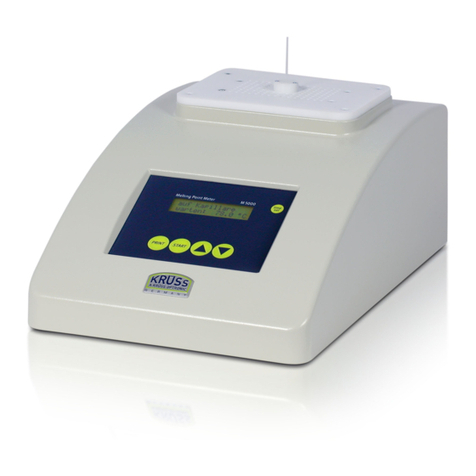
kruss
kruss M5000 User manual
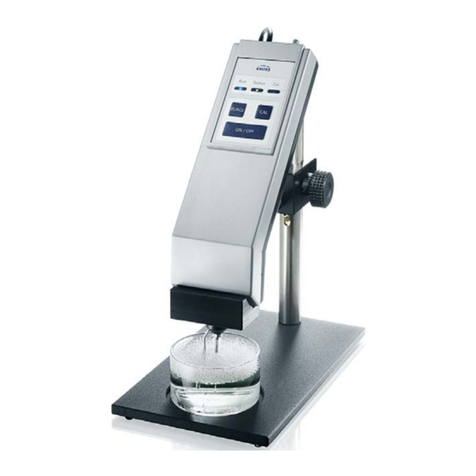
kruss
kruss BP50 User manual

kruss
kruss DR101-60 User manual

kruss
kruss M5000 User manual
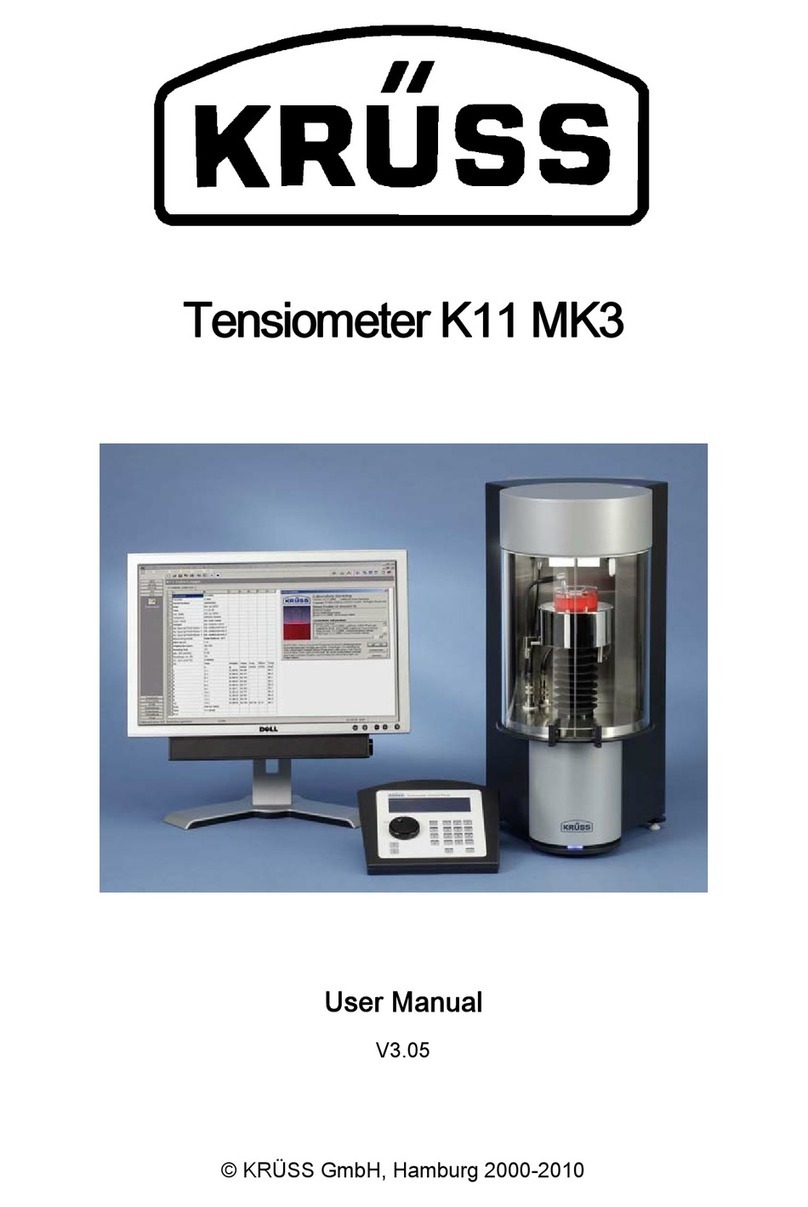
kruss
kruss K11 MK3 User manual
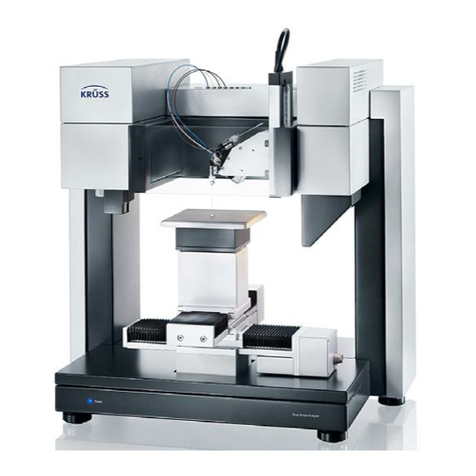
kruss
kruss DSA100 User manual

kruss
kruss M3000 User manual

